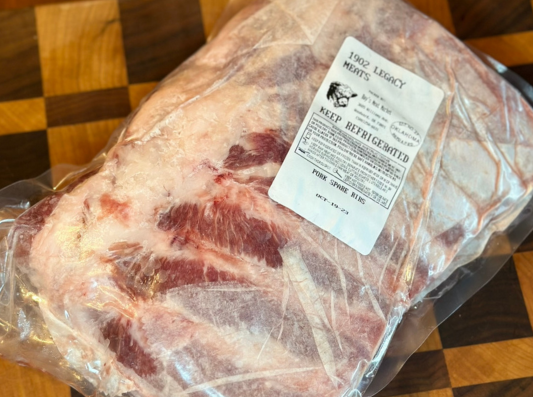What Our Grass-fed Cattle Eat in the Winter
posted on
January 24, 2023
“What do our grass-fed cows eat in the winter?”
When the weather takes a turn for the cold here in Oklahoma, ranchers like us are tasked with the challenge of keeping our grass-fed cattle well-fed and warm.
How do we do it, you ask? Put simply; it starts with ensuring that we are well stocked up on hay, liquid feed (more on that later), and by implementing a carefully planned grazing practice.
When it comes to keeping cattle warm in the winter, eating is critical!
By eating hay, and dormant prairie grass, the cattle generate heat from their rumens (multiple stomachs) to keep them warm.
Sadly, the drought this year has caused a critical shortage in our area's supply of grass hay. But we ranchers are resourceful and came up with a solution...corn hay!
What is corn hay?
To begin with, it isn't a grain. Corn is a type of grass species, and corn hay consists of the plant material before the growth of an ear. This innovative solution allows us to keep our cattle on a purely grass-fed diet even during severe droughts and harsh winter conditions.
However, even that isn't consistent enough to keep the cows warm and healthy during cold months, and they require some supplemental support.
During the winter months, our cattle are given liquid feed (commonly referred to as corn liquor). This beneficial ferment is packed with microbial bacteria for the cow's rumen that assist in digesting dormant grass and hay more efficiently.
Not only does this liquid feed supply a vital source of fat energy, but it also supplies extra protein that is essential to ensure optimal nutrition for cows during periods of drought or cold weather.
At our ranch, we prioritize our cattle's health above all else – therefore, supplementing their diet with liquid feed is necessary from time to time to keep them healthy and happy.
But let's not overlook another vital resource: water!
Keeping our cattle healthy and thriving during this time of year means ensuring they always have access to clean water.
To do so, we pull from an underground aquifer called the Ogallala Aquifer. We then use tanks throughout our pasture every half mile since each cow walks about that distance for water.
The Oklahoma winter is no joke getting down to -20 degrees at times – but with some willpower (and elbow grease!) we keep the water flowing! To prevent freezing and keep the watering system on track, we occasionally need to chip away at the ice that forms in the tanks.
Fun Fact: From time to time, an older "wiser" cow will attempt to break the ice by throwing their entire body weight against it. They are usually successful in their attempt!
Providing food and water is only one part of winter care; there are other winter considerations, such as grazing half the ranch and leaving select winter pasture grasses long enough for cover and windbreaks in the winter months.
Our cattle are remarkably resilient, having evolved to naturally grow a thick protective layer of fur in the fall that acts as insulation and helps keep them warm during the chillier winter months.
On especially frigid days, though, you may see a few snuggled up together for extra warmth.
When all is said and done, protecting and caring for our grass-fed cattle requires detailed planning and tireless dedication throughout all four seasons...no matter what Mother Nature throws at us.
We are unwavering in our commitment to providing a healthier, more sustainable future and pride ourselves on offering unparalleled attention and transparency in our ranching practices.
When you understand how your beef is being raised and processed, you can trust that it's safe and healthy for your family.
With over 100 years of experience under our belts perfecting grass-fed beef, you can trust that we know what it takes to make it the very best!



